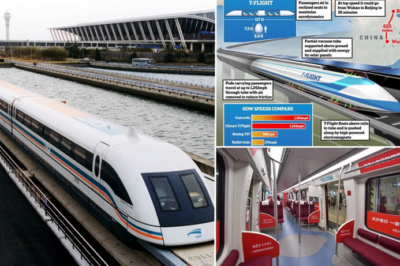
China has embarked on an ambitious project to revolutionize transportation with its latest maglev (magnetic levitation) train technology. Here’s everything you need to know about this groundbreaking development:
- A Step Toward Jet-Like Speeds
The new maglev line aims to transport passengers at speeds exceeding 621 mph (1,000 km/h), approaching the cruising speed of a Boeing 737 plane at 560 mph. - Maglev and Hyperloop Combination
The trains will operate within hyperloops—enclosed vacuum tunnels that reduce air resistance, enabling higher speeds and smoother travel. - China’s Existing Maglev Infrastructure
- The Shanghai Maglev, launched over two decades ago, remains the fastest commercial train globally, with peak speeds of 268 mph (431 km/h).
- The Changsha Maglev operates at a modest 62 mph but has served as a testing ground for further developments.
- The New Project
The latest construction involves a 30-mile (48.7 km) extension of the Changsha Maglev line to Liuyang in Hunan Province. The project is estimated to cost 10.44 billion yuan (£1.1 billion) and will have a designed speed of 100 mph (160 km/h). - Future Prospects
China envisions a nationwide maglev network integrating hyperloop technology, reducing travel times dramatically. For instance, traveling between Beijing and Shanghai—over 620 miles—could take less than two hours on a future maglev train. - Record-Breaking Prototypes
- The ‘T-Flight’ maglev train, developed by the China Aerospace Science and Industry Corporation, recently reached a speed of 387 mph during tests.
- Japan holds the world speed record for maglev trains, reaching 374 mph (603 km/h) on a test track in 2016.
- Advantages of Maglev Technology
- Eliminates wheel-track friction through magnetic levitation, enabling faster, quieter, and smoother journeys.
- Superior acceleration and deceleration compared to conventional trains.
- Challenges Ahead
While maglev technology promises a transportation revolution, significant hurdles remain, including:- High construction and operational costs.
- Engineering challenges to achieve and sustain extreme speeds.
- Integration with existing infrastructure.
- Global Maglev Efforts
Countries like Japan and Germany are also advancing maglev projects. However, development is slow due to cost and compatibility issues. - A Vision for the Future
China’s maglev ambition is a decades-long endeavor requiring substantial investment. However, if realized, it will set a new benchmark in transportation, making cross-country travel as fast as boarding a plane.
As construction progresses, China’s floating hyperloop train represents a bold leap toward the future of high-speed travel.






































Leave a Reply